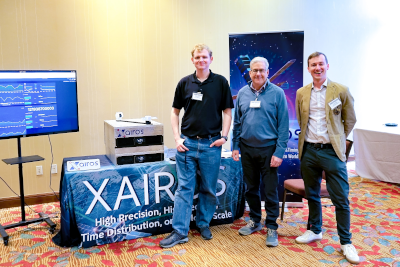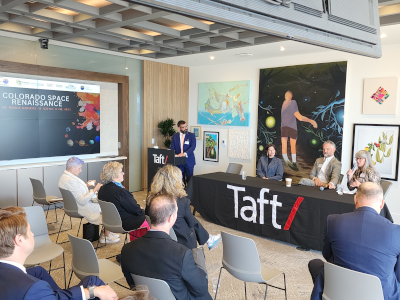
The Evolution of Space
In the last newsletter, we laid out the history of quantum from early theory to modern commercialization, thanks in part to government funding kicked off by the Manhattan Project. But there are also similar parallels to the space industry.
The Space Race (1950 – 1969)
It has been 80 years since mankind first slipped the surly bonds of Earth at the tail end of World War II, 68 years and 64 years since the first satellite and human in space, respectively, and 56 years since “one small step for man” on the moon. This breakneck pace of achievement had its own Manhattan Project, spurred by a World War and a Cold War.
In those early years, space was the domain of governments. The early space race was between enemies that didn’t want “to boldly go where no man has gone before,” but instead used space as a cover for developing ballistic missiles and spying. That changed with the Sputnik moment, and all of a sudden governments were using space to plant flags and claim bragging rights.
The Old Space Era (1989 – 2014)
But, as we have seen with the quantum industry, this government largess enabled development of practical satellites and launch vehicles, paving the way to commercial exploitation. After the last astronaut came back from the moon, and the iron curtain fell, space became a proper business. With the development subsidized, satellite operators, manufacturers, and launch vehicle providers already had global reach. But access to space was expensive and risky, so the business of space remained subsidized by governments and large sovereign telcos. And space imagery, science, exploration, and position, navigation, and timing (PNT) were still the domain of civil agencies.
The New Space Era (2014 – today)
A lot of ink has been spilled on the New Space Revolution, and on how, in the last decade, nearly $350B in investment in over 2000 new space companies is expected to grow to a $1.8T market by 2035. A lot of the credit goes to SpaceX, to be sure, but there were other pioneers: PanAmSat (and their infamous Spot logo), ABS, Skybox, and others, that showed that space could be a commercial business. Their success reduced the cost of access to space has by two orders of magnitude, which, in turn, increased the number of satellites to over 2000 a year!
This has created is a new trend towards convergence: space is no longer “the final frontier” – it is simply an extension of Earth. Traditional communication satellites are developing Direct-to-Device (D2D) and Satellite-to-Device (S2D) that integrate "satellite connectivity with terrestrial networks," space tourism is taking off, satellite imagery and video are readily available, and commercial companies are going to orbit and the moon.
With progress comes the negative side effect: the Earth's problems are also extending to space, whether it is conflict, congestion, or pollution (see below).
But space remains more than a place of business. Every human that has had the privilege of seeing the Earth, from space, as a "separate zip code," has experienced the overwhelming emotion of the Overview Effect: the awareness that Earth is a “tiny, fragile ball of life.”
Last Newsletter Theme: The Quantum Black Box
- Demonstrated Quantum Time Transfer at the CPIA Rocky Mountain Photonics Summit!

- Recently selected for a new funded project for a major customer interested in quantum timing. More news coming soon!
- In addition, working on a slew of active projects:
- Wrapped up the Phase I Final Review for Project Apollo.
- Completed a Detailed Design Review on Project Aristocles.
- Delivered mobilizers, optical terminal engineering models and modems for free-space optical communications field testing for the SDA project.
- Completed a Critical Design Review for the US Space Force Alt PNT Challenge.
- Working on a follow-on to the TNO-led KiQQer project.
- Held a Review for the Netherlands Ministry of Defense Quantum Challenge.
- Wrapping up a project with University of Colorado Quantum Forge students. One of their major takeaways was that "alignment is hard" - welcome to the world of quantum optics! And great job Ethan, Andrew, Conor, and Grayson!
- Our Marketing Lead Myrna James held court at two panels: the CSBR Space Renaissance and the International Women's Forum Colorado Space Panel:


- Preparing for a presentation at the Workshop on Synchronization and Timing Systems and the European Navigation Conference.
- The latest State of the Space Industrial Base 2024 report "underscores the urgency of defining a national strategy for space" noting that "competition with China and other state actors continues to shape the space domain."
- Meanwhile, China's investment in space tech startups surpassed the US in 2024 ($2.7B vs $2.6B) for the first time.
- The latest Center for Strategic and International Studies (CSIS) Space Threat Assessment report raised the alarm on the rise in GPS spoofing, noting that "The tactic, once rare, is now a normalized tool of hybrid warfare."
- The Program Executive Officer responsible for military communications and PNT talked about future capabilities for GPS, noting that "what ties that together for space-based GPS is the synchronized timing of the entire constellation... timing is critical," highlighting "that's where quantum can help us the most."
- The 2025 Stanford Emerging Technology Review notes the significant progress with quantum computing, but, despite this, only 5% of security and IT professionals "say their organizations have a defined quantum computing strategy" according to a global Quantum Computing Pulse Poll.
- Meanwhile, a UK-based tech company has released a music track that "blends generative AI with quantum circuits."
- The Quantum Sandbox for Near-Term Applications Act was introduced in the US Congress "to establish a public-private partnership for near-term quantum application development and acceleration."
- If you want to understand the future of warfare, it is robot dogs (which don't seem to work well) and lots and lots of drones (2,000,000 were built by Ukraine last year) connected with fiber optic cables so they cannot be jammed.
- Workshop on Synchronization and Timing Systems (WSTS), May 12 - 15, 2025, Savannah, GA
- European Navigation Conference, May 21 - 23, 2025, Wroclaw, Poland
- Joint Navigation Conference (JNC) 2025, June 2 - 5, Cincinnati, Ohio
- ION GNSS+ 2025, September 8 - 12, Baltimore, MD
- Quantum World Congress, September 16 - 18, Tysons, Virginia
- World Space Business Week, September 15 - 19, Paris, France
- International Timing and Sync Forum (ITSF), October 27 - 30, Prague, Czech Republic
- UK National Quantum Technologies Showcase, November 7, London, UK
- UK PNT Leadership Seminar, November, London, UK
As space becomes more accessible, business opportunities are flourishing. But with space traffic comes new problems.
One set of problems comes from
The shear number of new satellites, which has grown from "nearly 3 thousand in 2020 to almost 11 thousand in 2024." is creating a raft of new previously unforseen problems for:
- Astronomers that are worried about "light pollution that will affect even the remotest earthbound stargazer."
- The existing satellite networks and astronauts that are at risk due to crowding of satellites and space debris that could lead to a Kessler Syndrome, similar to the movie Gravity.
- Polution on Earth, caused by the de-orbiting satellites and other orbital debris that are re-entering the Earth's atmosphere and creating "concerns over the rising concentrations of metal particles and gases from satellites that can linger in the stratosphere for years, potentially catalyzing the destruction of ozone."
And this venture into space are also starting to create concern that a future war or conflict will extend into space - a literal Star War. The battle won't be fought between astronauts on the space station - though space lasers may be involved.
This concern is exacerbated by the modern world's reliance on GPS. If GPS was ever knocked out (and there are a lot of ways to do this, both overt and subtle), the world's networks, telecommunications, data centers, ATM and credit card transactions, and eventually power grids, would all degrade and possibly fail. A problem that malicious parties know all too well.

